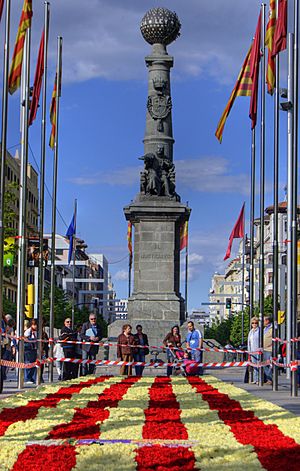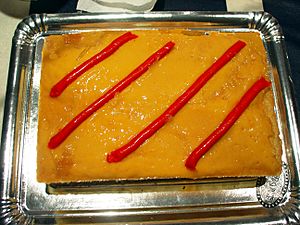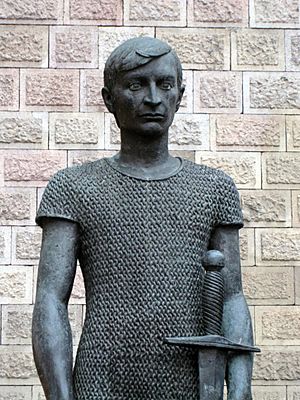Saint George's Day (Spain) facts for kids

Saint George's Day is a special celebration held on April 23rd each year. Sometimes, the fun even starts the day before, on April 22nd! Saint George is a very old and important figure, especially in Spain. People began honoring him around the year 1096. Legend says that King Peter I of Aragon won a big battle called the Battle of Alcoraz because Saint George helped him defeat his enemies. Many towns and cities in Spain honor Saint George because he helped them win important battles long ago. For example, the city of Cáceres has celebrated him as their patron saint since 1229 AD.
In the city of Alcoy, Valencia, the celebrations are very exciting. They have parades where people dress up as Moors and Christians, acting out old battles. But the main part of the celebration often focuses on a famous story: Saint George saving a princess by fighting a dragon!
Contents
The Legend of Saint George and the Dragon
Have you heard the amazing story of Saint George and the dragon? It's a tale told in many places, though some details might change.
A Kingdom in Danger
Long ago, in a place called Montblanch, a scary dragon was causing big trouble. It attacked the kingdom, making everyone very afraid. To keep the dragon from attacking their city, the people decided to give it two lambs every day. This kept the dragon happy and away from their homes.
A Brave Princess and a Heroic Knight
But soon, the lambs became scarce. The people had to make a difficult choice. They decided to send one person, chosen by chance, along with a lamb. If a family lost a member to the dragon, they would receive many riches as a reward.
One day, the princess herself was chosen by chance to be the dragon's next meal. As she waited in the dragon's cave, a brave knight named Jorge appeared! He fought the dragon with his sword and saved the princess.
A Rose and a Miracle
From the dragon's blood, a beautiful red rose bush grew. Knight Jorge picked a rose and gave it to the princess. The king offered Jorge many treasures, but the knight said no. He wanted the riches to be shared among the people of the kingdom instead. It is also said that a church was built in his name, and a special water flowed there that could heal sick people.
Saint George's Day in Aragon
The region of Aragon in Spain has always celebrated Saint George's Day with great excitement. It's their national holiday, called "Día de Aragón" (Day of Aragon). This day remembers the Battle of Alcoraz, when the city of Huesca was won by the Aragonese army. People believe that Saint George appeared during this battle, helping the Christian soldiers win at a very important moment.
Saint George's Day in Catalonia

In Catalonia, Saint George's Day is known as La Diada de Sant Jordi. It's also called El Dia de la Rosa (The Day of the Rose) or El Dia del Llibre (The Day of the Book). This special day is celebrated on April 23rd, and it has been a big event since 1926.
Roses and Books for Loved Ones
The main tradition is for people to exchange roses and books with their sweethearts, family, and friends. It's a bit like Valentine's Day, but many Catalans feel this is their true day of love. Historically, men gave women roses, and women gave men a book. The idea was "a rose for love and a book forever." Today, everyone often exchanges both roses and books.
Roses have been part of this day since medieval times. But giving books is a newer tradition. It started in 1923 when a bookseller wanted to celebrate the deaths of two famous writers, Miguel de Cervantes and William Shakespeare. Both writers died on April 23rd, though not in the same year because different calendars were used back then. Barcelona is a major city for publishing books in both Catalan and Spanish. So, the idea of combining love and reading quickly became popular.
A City Full of Festivities
On this day, La Rambla, a famous street in Barcelona, and many other places in Catalonia are filled with thousands of stalls selling roses and books. By the end of the day, millions of roses and hundreds of thousands of books are sold! Many women carry a rose, and about half of all books sold in Catalonia each year are bought on this day.
The sardana, which is the national dance of Catalonia, is performed all day in the Plaça Sant Jaume in Barcelona. Many bookstores and cafes host readings by authors. Sometimes, they even have 24-hour marathon readings of classic books. Street performers and musicians add to the festive atmosphere.
April 23rd is also one of the few days when the Palau de la Generalitat, Barcelona's main government building, is open to the public. Inside, it is decorated with roses to honor Saint George.
A Worldwide Celebration
Catalonia's tradition of exchanging books and roses has even spread around the world. In 1995, UNESCO decided that April 23rd would be World Book Day.
Saint George's Day in Valencia
The Community of Valencia also celebrates Saint George's Day, though it's a bit different in various areas. In some parts, it's similar to Valentine's Day, just like in Catalonia.
The Alcoy Festival
One of the most famous celebrations is in the city of Alcoi. Here, Saint George's Day is a big thank-you celebration. People believe Saint George helped Christian soldiers fight against Muslims during a siege of the city long ago. To remember this, thousands of people dress up in medieval costumes. They form two "armies" of Moors and Christians and act out the siege that led to the city being won by the Christians.



